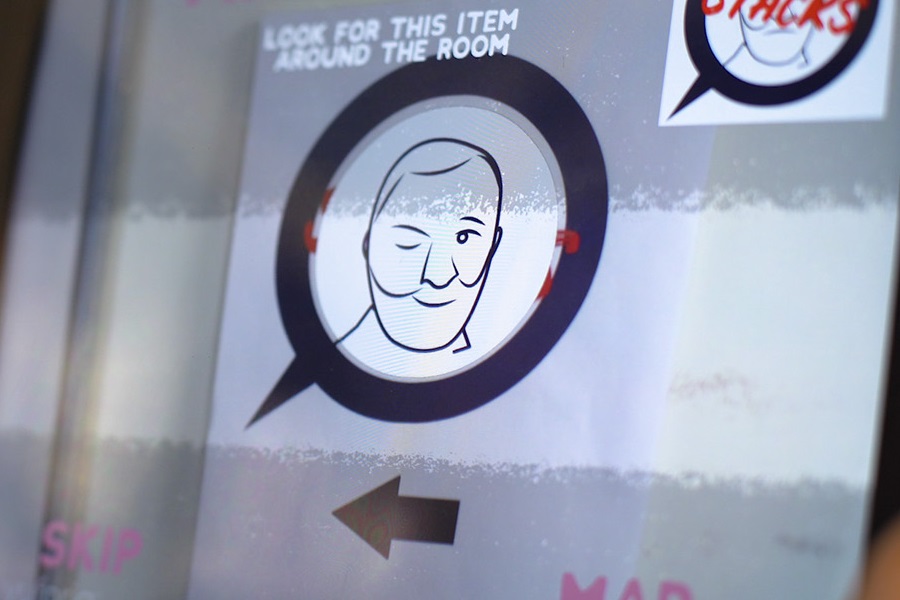
Augmented-Reality App Highlights Pittsburgh History at Carnegie Library
This story was originally published on cmu.edu/news.
The Carnegie Library's newest tour guide fits into the palm of your hand.
Carnegie's Monocle, an app created by Carnegie Mellon University students, leads library visitors through an augmented reality-driven scavenger hunt that highlights sights and sounds from Pittsburgh's history. It also helps guests explore less-traveled areas of the library and hear pieces from its extensive historic music collections.
The project combined the talents of students in this spring's Real-Time Animation and Experimental Sound Synthesis classes, said Johannes DeYoung, assistant professor in CMU's School of Art who taught the Real-Time Animation class. DeYoung said the students researched the library's collections, found content that sparked their imaginations, and activated those collections through a mixed-reality tour driven by an augmented-reality app.
"This total experience is an amalgamation of different research investigations from students working in collaboration with the library and also working in collaboration with each other across schools, including the School of Art, School of Music and the IDeATe program," DeYoung said.
The app directs participants to different frescos, signs, paintings and objects along a winding path throughout the library's second floor. When a participant holds a phone up to the correct object, animations dance across the device's screen.
The path also directs guests to art installations focused on different areas of Pittsburgh. An instrument controlled by hand movements in the air combines the "South Side Polka" with sounds from Hofbrauhaus's beer hall. A sound corridor along the library's stacks takes patrons through a series of compositions based off of the "Shadyside Mazurka," an 1873 Polish dance song. In homage to the Duquesne Incline, a phone booth installation incorporates samples of the funicular's clacking. By dialing a year, visitors can call up a handful of radio programs from over the past century.

The installations and app, which is available on the iTunes App Store and Google Play, will be in the library through the end of June.
Tara Goe, one of the Carnegie Library's music, film and audio librarians, hopes the project will expose visitors to the library's musical offerings, including its loanable electronic instruments and historic sheet music collection. Goe said the sheet music collection dates back to the 1890s and the department houses one of the largest public library music collections in the country.
"Some patrons primarily visit our first floor to pick up books," Goe said. "We hope this art walk will bring attention to our rich music collection and entice people to explore areas where they might be less familiar."
Annie Hui-Hsin Hsieh, who taught the Experimental Sound Synthesis class, said for many of the students the project was their first experience creating work that engaged directly with the public.
"Through the project, they started to realize, 'Why am I mounting this piece here? What is the purpose? Who is going to be using this? And is this a practical solution to do what we're attempting to do?'" said Hsieh, an assistant teaching professor in CMU's School of Music. "I saw them starting to understand the function of their work in a public space, which is always very valuable knowledge to have."
Additionally, DeYoung said the project's emphasis on cross-disciplinary teamwork became an important learning experience for many of the students.
Sheenu You, a College of Fine Arts senior who helped build the app's user interface, said he learned the importance of communicating with a team, especially when working on something as complex as an app.
LeRoy Gary, a recent College of Engineering graduate who worked on the musical installation in the stacks, said his engineering skillset complemented his teammates' expertise in music performance and composition. Gary measured wiring, created a system to loop six music tracks and helped record sounds in Shadyside for sampling. By the end of the project, he had learned technical skills that he hopes to use elsewhere.
"I would gladly work with other artists as an engineer to help create more ambitious installations," Gary said. "Most of all, I want to see other people get inspired to make their own art installations. What we made wasn't especially complicated, it just combined music styles from a few generations and played it. Anybody with an MP3 player and an idea could do something similar."